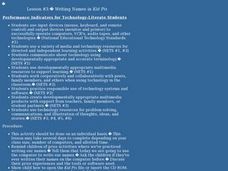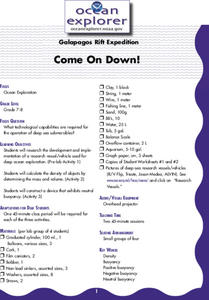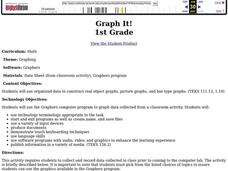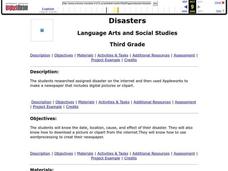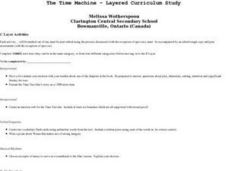Curated OER
Sensing Somethong
Students are taught that they can gather information about objects using the five senses of vision, touch, smell, taste, and hearing. They are told that some sensing, like sight, is done remotely. Students observe how a camera can...
Curated OER
Positive Futures Fair
Students, in groups, research an issue they feel is significant in today's world. They present and justify specific actions for the audience to take that would help to better the issue of public concern.
Curated OER
Life before Congress
Pupils name some interesting backgrounds of Members of Congress, identify their current representatives in the legislative branch of the national government, and describe the background of one local representative or senator.
Curated OER
Graphing Water Temperature
Learners graph water temperature using probe software and a Palm on a class field trip to a lake or pond. Emphasis is placed on collaboration with high school science students and the use of ImagiProbe software.
Curated OER
Charlie and the Chocolate Factory
Eighth graders read and discuss Charlie and the Chocolate Factory. Then they invent a candy bar, name it and draw a picture of it. Finally, they write a short descriptive paragraph about it.
Curated OER
Technology: Self-Portraits
Students use Kid Pix to create self-portraits. Using mirrors, they create accurate renditions of themselves on the computer. They print the portraits and display them in the classroom.
Curated OER
Power Point Presentation
Students use multimedia to create presentations. The national technology standards are used to have a foundation for technology usage. The users of this lesson should be technology literate before attempting the preparation.
Curated OER
Technology: Locating Home on the Internet
Second graders use Yahoo to locate their home locations on maps. They discover the diatances from their homes to school to determine who lives the closest. They experience the Internet as a source for information.
Curated OER
Self-Portraits
Students use a software drawing program to produce self portraits. They draw using the available tools and matching their features such as eye color and shape. They print the portraits for a classroom display.
Curated OER
Writing Names in Kid Pix
Students review the ways they learned to write their names before using a software program to write their names on the computer. They use a number of different tools available with the software including fonts, backgrounds and sizes....
Curated OER
Technology: Paper Roll Photo Dolls
Students use paper rolls covered with construction paper as backgrounds for their individual photos. The photos are printed using Adobe Photo Deluxe and locate their pictures by finding their names on the files. Students are videotaped...
Curated OER
Power Point Presentation
Students create a PowerPoint presentation using photographs from a previous lesson. Using the program, they are introduced to how the software operates and discovers the things that it can do to help present information. They share their...
Curated OER
Galapagos Rift Expedition Come On Down!
Students research the development and implementation of a research vessel/vehicle used for deep ocean exploration. In this oceanography lesson, students calculate the density of objects by determining the mass and volume.
Curated OER
Data Gathering: Vietnam
Students study the Vietnam Era by interviewing people and writing a questionnaire to gather data on the attitudes, feeling, and experiences of the interviewee during this era.
Curated OER
Cause and Effect Slide Show
Second graders use KidPix software to create a slide show demonstrating their understanding of cause and effect in literature.
Curated OER
Pictograph to Bar Graph
Second graders explore organizing data to make it useful for interpreting picture graphs and bar graphs. They use Graphers software to create a pictograph and a bar graph.
Curated OER
Graph It!
First graders use organized data to construct real object graphs, picture graphs, and bar-type graphs.
Curated OER
Production Time
Seventh graders identify terms related to computer-generated productions (e.g., desktop publishing, WYSIWYG, clip art, hypertext, multimedia, laserdisc, CD-ROM, VCR, scanners, camcorders).
Curated OER
Disasters
Third graders examine different types of disasters occurring in our world. They research an assigned disaster on the Internet then create a newspaper to display their information including clipart and digital pictures.
Curated OER
Zany Zoo Adventures
First graders create web pages. They design story books using digital camera pictures. They explore the Lowry Park Zoo web site. They visit Lowry Park Zoo and take pictures of animals.
Curated OER
Dental Health
Young scholars watch a presentation about how cavities are formed, view a dentist office on the Internet. Students make a class book about teeth after taking digital pictures of teeth.
Curated OER
The Time Machine - Layered Curriculum Study
High schoolers complete three activities of their choice from a given list surrounding their study of H.G. Wells' novel, The Time Machine. They choose activities from each of the seven learning styles.
Curated OER
Breaking News English: BBC Nets Best Net News Award
In this English worksheet, students read "BBC Nets Best Net News Award," and then respond to 30 fill in the blank, 25 short answer questions about the selection.











